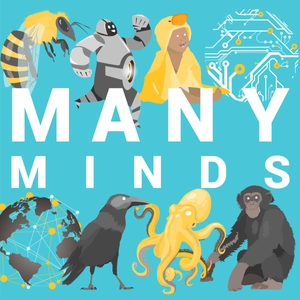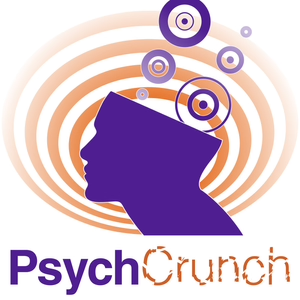
What is language for?
04/13/22 • 77 min
Welcome back friends and happy spring! (Or fall, as the case may be.) Today's show takes on a disarmingly simple question: What is language for? As in, why do we say things to each other? What do words do for us? Why do our languages label some aspects of the world, but not others? My guest today is Dr. Nick Enfield. He's Professor of Linguistics at the University of Sydney. Nick has authored or edited more than a dozen books on different aspects of human language and communication—books on word meaning, gesture, conversation, social interaction, the languages of Southeast Asia, and more. His latest book, just published by MIT press, is titled Language vs Reality: Why Language is Good for Lawyers and Bad for Scientists. In it, Nick argues that language is pretty awful at capturing reality—but actually that's fine, because capturing reality isn’t the primary reason we use it. The real reason, in his view, is to coordinate with others. In this conversation, Nick and I flesh out this way of thinking about language as foremost a social coordination tool. Along the way, we talk about the two "reductions" that happen as brute reality gets transmuted into words. We discuss the economist Thomas Schelling and so-called Schelling maps. We talk about color words and plant names, salt and spoons, the insights of Benjamin Lee Whorf, the idea of “verbal overshadowing,” and a bunch of other phenomena and thinkers.
As I say in the interview, Nick has one of the most expansive views of human language of anyone I know. He draws on anthropology, economics, primatology, developmental psychology, not to mention decades of his own fieldwork in Laos. That expansive—one might say, "many minded"—perspective is on full display here.
Briefly, before we get to the conversation: if you have any ideas for future guests or topics—or want to lodge some criticisms—you can reach out to us at [email protected]. That's [email protected]. We're always eager to hear from listeners.
Alright friends, now to my conversation with Dr. Nick Enfield. Enjoy!
A transcript of this episode is available here.
Notes and links
10:00 – Dr. Enfield’s 2002 edited book on “ethnosyntax.” Here is a brief overview of serial verb constructions.
15:30 – Dr. Enfield has another book coming out later this year, with Jack Sidnell, titled Consequences of Language.
20:00 – The website of the influential semanticist Anna Wierzbicka, one of Dr. Enfield’s early mentors.
22:45 – Roger Brown’s classic 1958 paper ‘How shall a thing be called?’
24:30 – Daniel Dor’s 2015 book, The Instruction of the Imagination.
25:40 – A popular article about the contributions of the economist Thomas Schelling. Another article on his notion of “focal points.”
37:00 – The classic treatment of color terms across languages is Berlin & Kay’s 1991 book Basic Color Terms.
40:00 – Dr. Enfield spent a large portion of his early career at the MPI for Psycholinguistics.
44:45 – The classic treatment of plant names across cultures is Berlin’s book, Ethnobiological Classification.
49:30 – Dr. Enfield has been documenting Kri, an indigenous language in Laos.
53:00 – The classic study on “verbal overshadowing” was done by Schooler & Engstler-Schooler in 1990.
58:20 – A classic paper by Krebs and Dawkins on signaling in nonhuman anim...
Welcome back friends and happy spring! (Or fall, as the case may be.) Today's show takes on a disarmingly simple question: What is language for? As in, why do we say things to each other? What do words do for us? Why do our languages label some aspects of the world, but not others? My guest today is Dr. Nick Enfield. He's Professor of Linguistics at the University of Sydney. Nick has authored or edited more than a dozen books on different aspects of human language and communication—books on word meaning, gesture, conversation, social interaction, the languages of Southeast Asia, and more. His latest book, just published by MIT press, is titled Language vs Reality: Why Language is Good for Lawyers and Bad for Scientists. In it, Nick argues that language is pretty awful at capturing reality—but actually that's fine, because capturing reality isn’t the primary reason we use it. The real reason, in his view, is to coordinate with others. In this conversation, Nick and I flesh out this way of thinking about language as foremost a social coordination tool. Along the way, we talk about the two "reductions" that happen as brute reality gets transmuted into words. We discuss the economist Thomas Schelling and so-called Schelling maps. We talk about color words and plant names, salt and spoons, the insights of Benjamin Lee Whorf, the idea of “verbal overshadowing,” and a bunch of other phenomena and thinkers.
As I say in the interview, Nick has one of the most expansive views of human language of anyone I know. He draws on anthropology, economics, primatology, developmental psychology, not to mention decades of his own fieldwork in Laos. That expansive—one might say, "many minded"—perspective is on full display here.
Briefly, before we get to the conversation: if you have any ideas for future guests or topics—or want to lodge some criticisms—you can reach out to us at [email protected]. That's [email protected]. We're always eager to hear from listeners.
Alright friends, now to my conversation with Dr. Nick Enfield. Enjoy!
A transcript of this episode is available here.
Notes and links
10:00 – Dr. Enfield’s 2002 edited book on “ethnosyntax.” Here is a brief overview of serial verb constructions.
15:30 – Dr. Enfield has another book coming out later this year, with Jack Sidnell, titled Consequences of Language.
20:00 – The website of the influential semanticist Anna Wierzbicka, one of Dr. Enfield’s early mentors.
22:45 – Roger Brown’s classic 1958 paper ‘How shall a thing be called?’
24:30 – Daniel Dor’s 2015 book, The Instruction of the Imagination.
25:40 – A popular article about the contributions of the economist Thomas Schelling. Another article on his notion of “focal points.”
37:00 – The classic treatment of color terms across languages is Berlin & Kay’s 1991 book Basic Color Terms.
40:00 – Dr. Enfield spent a large portion of his early career at the MPI for Psycholinguistics.
44:45 – The classic treatment of plant names across cultures is Berlin’s book, Ethnobiological Classification.
49:30 – Dr. Enfield has been documenting Kri, an indigenous language in Laos.
53:00 – The classic study on “verbal overshadowing” was done by Schooler & Engstler-Schooler in 1990.
58:20 – A classic paper by Krebs and Dawkins on signaling in nonhuman anim...
Previous Episode

From the archive: The root-brain hypothesis
Friends—we're busy with some spring cleaning this week, but will be back in mid-April. In the meanwhile, here's a favorite audio essay from our archives. Enjoy!
______
Welcome back folks! Today is a return to one of our favorite formats: the audio essay. If you like your audio essays short, concise, and full of tidbits, then this one will not disappoint.
We take a look at a 140-year-old idea but very much a radical one—the root-brain hypothesis. It was proposed by Charles Darwin in a book published in the twilight of his career. The idea, in short, is that plants have a structure that is, in some ways, brain-like—and it is located underground, at their roots. We talk about how Darwin and his son Francis arrived at this idea, why it was ignored for so long, and how it’s recently stirred to life.
Enjoy!
A text version of this essay is available here.
Notes and links
2:15 – The last page of Darwin’s The Power of Movement in Plants (1880).
3:25 – The 2009 paper by Dr. Baluška and colleagues about the history and modern revival of the “root-brain hypothesis.”
6:00 – The tinfoil hats experiment—and its influence—is discussed in this 2009 paper.
8:00 – The dust-up between Darwin and Sachs is described in this 1996 paper.
8:47 – The 2011 paper listing many of the environmental variables plants are now known to be sensitive to.
9:28 – Dr. Gagliano and colleagues’ paper on associative learning in plant and on plants’ use of sounds to find water. The possibility of echolocation is discussed here.
9:45 – For broader context surrounding the question of plants may have something like a brain, see Oné R. Pagán's essay titled 'The brain: A concept in flux.'
9:57 – The 2006 paper that inaugurated the field of “plant neurobiology.”
10:34 – Discussions of the “transition zone” of the root can be found in the 2009 paper by Baluška and colleagues, as well as in this more technical paper from 2010.
11:00 – The response letter to the original “plant neurobiology” paper, signed by 36 plant biologists.
12:00 – Michael Pollan’s 2013 article ‘The Intelligent Plant’ in The New Yorker.
12:05 – Anthony Trewavas’s letter, highlighting the power of metaphors in science.
12:26 – The 2020 paper about pea tendrils in Psychonomic Bulletin & Review.
Correction: The audio version of this episode misstates the publication year of Darwin's final book, about worms. The correct year is 1881, not 1883.
Many Minds is a project of the Diverse Intelligences Summer Institute (DISI) (https://disi.org), which is made possible by a generous grant from the Templeton World Charity Foundation to UCLA. It is hosted and produced by Kensy Cooperrider, with help from assistant producer Cecilia Padilla. Creative support is provided by DISI Directors Erica Cartmill and Jacob Foster. Our artwork is by Ben Oldroyd (https://www.mayhilldesigns.co.uk/). Our transcripts are created by Sarah Dopierala (https://sarahdopierala.wordpress.com/).
You can s...
Next Episode

Animal minds and animal morality
Your friend is in a bit of distress. They’ve just been dunked in a pool, and they can’t pull themselves out. You’re looking on as they’re paddling furiously, trying to hold onto the pool’s ledge. Fortunately, there’s a way to save your friend, to give them an escape route. The thing is, there’s also something else vying for your attention at the moment: a chunk of chocolate. So what do you do? Do you first nab the chocolate and then free your friend?
Turns out that most rats in this position—that’s right, rats—will first free their friend and then go for the chocolate. This is one of many studies that have raised profound questions about whether animals are moral beings, about whether they are capable of things like care and empathy. Such studies are doing more than raising questions about animal morality, though; they’re also reshaping our understanding of what animal minds are capable of.
My guests today are not one but two philosophers: Dr. Kristin Andrews, Professor of Philosophy at York University in Toronto and Dr. Susana Monsó, Assistant Professor in the Department of Logic, History, and Philosophy of Science at UNED in Spain. Both Susana and Kristin have emerged as central figures in the new conversations and debates that springing about animal minds and animal morality.
We cover a lot of ground in this episode. We talk about rats and empathy. We discuss the role of philosophy in the crossdisciplinary study of animal cognition. We talk about Kristin’s most recent book, which is a critical consideration of how scientists are trained to study animals, and Susana’s book, which is an extended investigation into animals’ understandings of death. We zoom in on the “animal morality debate”—about whether animals should be considered moral beings. We consider how touch might inform the debate and social norms and morality are deeply enmeshed than you may realize. As we navigate these lofty ideas, we also touch on the use of thermography to study emotions in marmosets, planning in orangutans, tongue-biting in orcas, and playing dead in possums.
This is basically a double episode. It features two amazing guests. It takes on two big topics—the study of animal minds in general and the animal morality debate in particular. It’s also a tad longer than our usual fare, but I promised its packed with useful frameworks, provocative findings, and a bunch of open questions. I think it also picks up steam as we go—so be sure to stick with it, through to the second half.
Alright folks, as always, thanks so much for listening. And be sure to send us your guest and topic ideas, your glowing reviews, and your crotchety comments. You can reach us on Twitter or by email at [email protected].
Now for my conversation with Dr. Susana Monsó and Dr. Kristin Andrews. Enjoy!
A transcript of this episode is available here.
Notes and links
5:00 – An essay by Dr. Andrews & Dr. Monsó in Aeon magazine, about how rats deserve ethical protections.
7:30 – A popular article about findings that vervet monkeys socially learn food preferences. The original research paper is here.
9:10 – A popular article on the findings that rats can learn to play hide-and-seek.
22:00 – Dr. Andrews’ most recent book is How to Study Animal Minds. Her earlier book, The Animal Mind, is now out in a second edition.
24:00 – Morgan’s Canon has been widely discussed and criticized in recent decades (see here, here, and here).
27:00 – A paper by Dr. Andrews on the role of folk psychology in animal cognition research.
33:00 – A paper by Dr. Andrews discu...
If you like this episode you’ll love
Episode Comments
Featured in these lists
Generate a badge
Get a badge for your website that links back to this episode
<a href="https://goodpods.com/podcasts/many-minds-208775/what-is-language-for-21934050"> <img src="https://storage.googleapis.com/goodpods-images-bucket/badges/generic-badge-1.svg" alt="listen to what is language for? on goodpods" style="width: 225px" /> </a>
Copy





